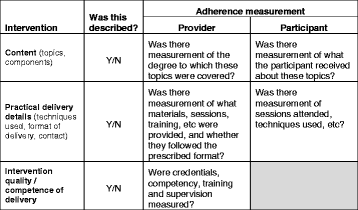Measurement of adherence in a randomised controlled trial of a complex intervention: supported self-management for adults with learning disability and type 2 diabetes
- PMID: 27716063
- PMCID: PMC5052902
- DOI: 10.1186/s12874-016-0236-x
Measurement of adherence in a randomised controlled trial of a complex intervention: supported self-management for adults with learning disability and type 2 diabetes
Abstract
Background: Reporting adherence to intervention delivery and uptake is a detailed way of describing what was actually delivered and received, in comparison to what was intended. Measuring and reporting adherence is not routinely done well in complex interventions. The OK Diabetes trial (ISRCTN41897033) aimed to develop and subsequently test the feasibility of implementing a supported self-management intervention in adults with a learning disability and type 2 diabetes. A key study objective was to develop a measure of adherence to the intervention.
Methods: We conducted a systematic review of published literature, extracting data from included papers using a standardised proforma. We undertook a narrative synthesis of papers to determine the form and content of methods for adherence measurement for self-management interventions in this population that had already been developed. We used the framework and data extraction form developed for the review as the basis for an adherence measurement tool that we applied in the OK Diabetes trial.
Results: The literature review found variability in the quality and content of adherence measurement and reporting, with no standardised approach. We were able to develop an adherence measure based upon the review, and populate it with data collected during the OK Diabetes trial. The adherence tool proved satisfactory for recording and measuring adherence in the trial.
Conclusion: There remains a need for a standardised approach to adherence measurement in the field of complex interventions. We have shown that it is possible to produce a simple, feasible measure for assessing adherence in the OK Diabetes trial.
Keywords: Adherence; Complex interventions; Fidelity; Learning disability; Reporting standards; Self-management; Type 2 diabetes.
Figures
References
-
- NICE guidelines [PH49] Behaviour change: individual approaches. 2014. http://guidance.nice.org.uk/PH49
-
- Albrecht L, Archibald M, Arseneau D, Scott SD. Development of a checklist to assess the quality of reporting of knowledge translation interventions using the workgroup for intervention development and evaluation research (WIDER) recommendations. Implement Sci. 2013;8:52. doi: 10.1186/1748-5908-8-52. - DOI - PMC - PubMed
Publication types
MeSH terms
Grants and funding
LinkOut - more resources
Full Text Sources
Other Literature Sources
Medical


